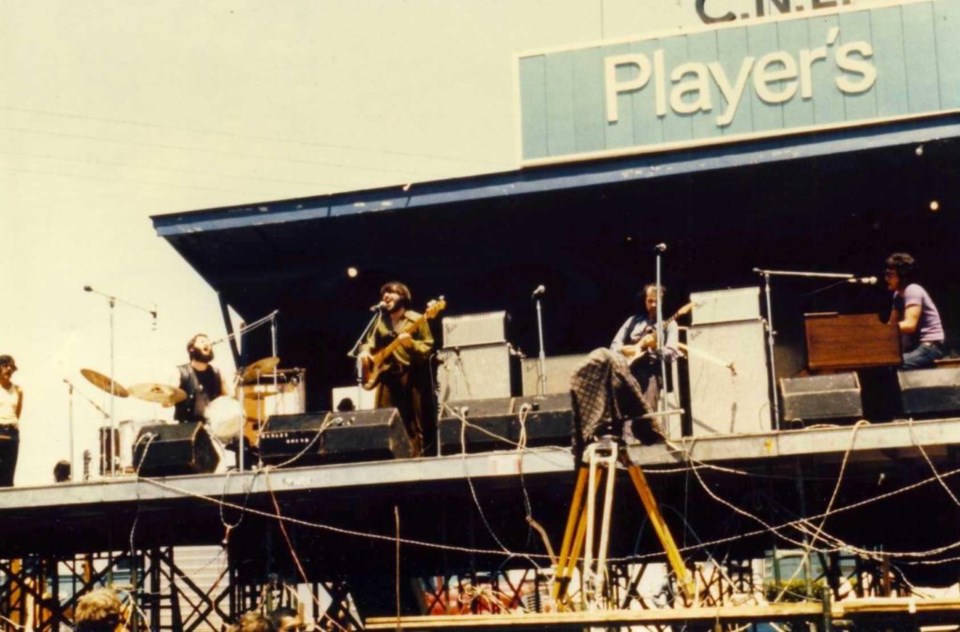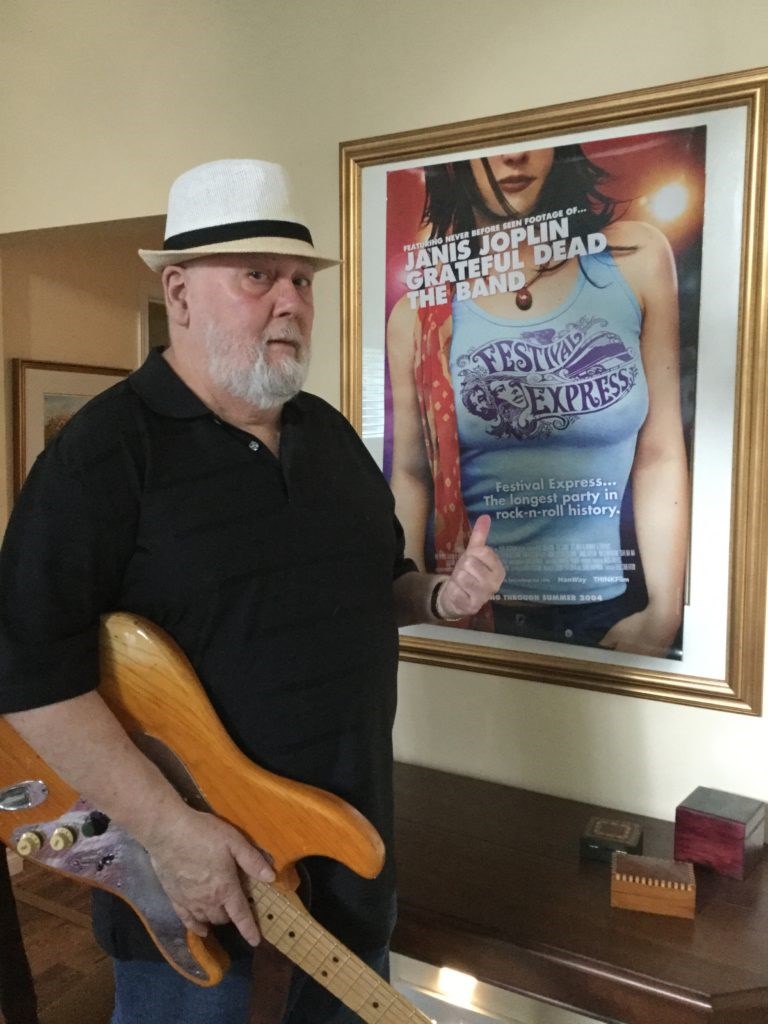
Last week marked the 50th anniversary of a unique event in rock and roll history. It happened in Canada, and Niagara-on-the-Lake resident Rayburn Blake was a big part of it.
Originally billed as The Transcontinental Pop Festival, The Festival Express brought together some of the biggest names in rock for a cross-Canada tour, moving from city to city via a Canadian National train.
It was like Woodstock on rails. The Grateful Dead, Janis Joplin, The Flying Burrito Brothers, Mountain, Delaney & Bonnie & Friends, Ian & Sylvia, Eric Anderson, Tom Rush and Buddy Guy played shows in Toronto, Winnipeg and Calgary. Other acts, such as Traffic, and Ten Years After, joined them for one-off appearances. The Band jumped on the train part-way through.
As the guitarist in Montreal-based band Mashmakhan, who performed at all three stops, Blake was along for the entire ride.

Now 76 years old and living with his partner Charmian in the Chautauqua area of town, Blake says riding that train was just one of the many highlights of his life as a touring musician.
Mashmakhan burst onto the scene in 1969 with their debut self-titled album. As the Years Go By, the first single from the Columbia Records release, went to the top of the charts in Canada, and sold more than a million copies worldwide. In May, 1970, they played their first Toronto show at Massey Hall, opening for another band with a debut album out on Columbia, Santana.
“It’s an oddity of a song,” he says now, “a little bit of a fluke, and it didn’t always represent what the group was. Columbia didn’t think we had a hit on the record. Then one of the radio DJs, I think it was Roger Ashby, played this cut, and the switchboards lit up, and within three weeks other stations picked it up, and Columbia released it as a single.”
It stayed atop the Canadian charts for weeks, which is surely one of the reasons the band’s booking agent, Donald K. Donald, and manager, Terry Flood, were able to get the band a spot on the train.
Originally, The Festival Express was scheduled to start in Montreal on June 24, 1970. Mayor Jean Drapeau, however, put the kibosh on that, as that date was also St. Jean-Baptiste Day, the religious holiday in Quebec.
So the musicians and their support teams gathered in Toronto at the Anndore Hotel & Apartments, prior to the two dates at CNE Stadium, June 27 and 28.
It was raining when Blake arrived, and the first person he noticed was one of the tour’s biggest stars. “Janis Joplin was sitting there on a stone fence. I didn’t speak to her because I didn’t know her. But she wouldn’t go in until Ron ‘Pigpen’ McKernan of the Grateful Dead turned up.”
“Unfortunately, the rumours were true,” he adds. “She was high all the time. But she was the most pleasant alcoholic I had ever met.”
The Toronto shows were a bit chaotic. The 2003 documentary film titled Festival Express, pieced together from footage that had been buried in a Toronto garage for decades, shows throngs of long-haired fans storming the gates. They were protesting the ticket price ($9 for one day, $14 for the two concerts) for the shows. It seemed the Woodstock ‘hangover’ had given this group the opinion that music should be free. Police on horseback scrambled to quell the riot. Jerry Garcia of the Grateful Dead offered to play a free set with a group of other musicians outside the gates to placate the intruders.
“Jerry turned out to be kind of a father/mentor type,” says Blake. “Thousands of people were following the Dead around the continent. When he spoke, he was a gentle man.”
According to Blake, the first morning on the train, Garcia called a meeting, and asserted mildly that all involved had to agree to make the sojourn a “musicians’ trip.” That meant just the musicians, their roadies and the two journalists invited along were to ride the train. Blake says one musician snuck a groupie onto the train at one point, and was severely chastised for the faux pas.
Despite that one transgression, it really was a musicians’ trip. Though Mashmakhan was certainly not top of the bill, Blake says, in the spirit of the ’60s, there was really no hierarchy amongst the participants. Things were free and easy during the constant jam sessions which brought musicians together 24 hours a day in the antique cars designated for such.
Of those jam sessions, Blake remembers Janis Joplin learning how to play Me and Bobby McGee on guitar. He recalls Leslie West of Mountain wringing a sound out of his Les Paul that was as gigantic as the man himself, despite the smaller amps on the train.
“One of the first days on the train, some of Buddy Guy’s band were playing, and Jerry Garcia was playing his infamous Gibson SG with the peace sign on it,” says Blake. “I’m sitting there watching, and he says, ‘I saw you play last night, pretty nice, here you go,' and he handed me his guitar. That was definitely a highlight of the trip.”
The Winnipeg show took place on Canada Day in front of a disappointingly small crowd. That was partly due to fears of crowd violence after the incident at the Toronto shows. In the film, a short clip of Blake and Mashmakhan at the Winnipeg Stadium gives the viewer an idea as to how good the band was.
“The audience reaction was so good that someone said, ‘get the cameras rolling,’ but by the time they did that, we were almost finished our set. Jerry Mercer (their drummer, later of April Wine) called out for us to play I’m Comin’ Home, Baby (made famous by Herbie Mann), and that’s what you see us playing there.”
Of course, there were drugs and alcohol on the train. Blake says on both legs of the journey they made many whistle stops, primarily to connect with local pot dealers to replenish the supply. As well, anywhere the Grateful Dead went, there was sure to be LSD. According to Blake, the LSD on this trip was the last of the infamous original batch cooked up by famous San Francisco chemist and Dead roadie, Owsley Stanley III.
The film certainly doesn’t hide the party atmosphere on the tour. At one point it stops in Saskatoon after they had run out of booze. A collection was taken amongst all those onboard, and they visited a liquor store, where they spent about $800, also leaving with a big display bottle of Canadian Club whiskey. Legend has it the giant bottle was spiked with some of that pure LSD.
With the jam sessions, the drugs and the alcohol, there wasn’t a lot of sleeping going on. Many of the musicians were having so much fun they didn’t want to miss a minute of it.
The crowds were better at McMahon Stadium in Calgary, July 4 and 5, the final stop on the tour (a planned Vancouver show had been previously cancelled when PNE Empire Stadium became unavailable). When it was all over, Blake and his young bandmates had played to more than 60,000 fans over the five dates, and made music history in the process.
Mashmakhan released another album in 1971, and disbanded shortly after. Blake went on to form a new band, Riverson, whose one release remains a highly-sought-after collectors item on vinyl. Riverson included singers Frankie Hart and Mashmakhan’s Brian Edwards. Coincidentally, Graham Lear, who also now lives in NOTL, played drums on the album. Following that, Blake spent about seven years playing guitar in the Lisa Hartt Band, who released the album Starwatcher in 1976, and he performed as a session musician, before retiring from the road. Eventually, he began working at Steve’s Music Store, and then Long and McQuade in Toronto, first selling, then repairing guitars.
These days he keeps busy in his home studio, where he records and masters music for other artists. He also teaches guitar lessons, and before the pandemic, he had begun to play the open mic nights at the Royal Canadian Legion hall on King Street.
Was The Festival Express the highlight of his career? Blake claims that’s a tough question. Other big moments include Mashmakhan’s 10-day, two-date trip to Japan in 1971, where As the Years Go By made them the first foreign band to top the charts. That’s a distinction they held until a Korean band followed suit in 2012.
While there, they opened shows for Grand Funk Railroad in Tokyo and Osaka to their biggest crowds ever. That event could form another entire story.
A month spent playing an outdoor gig in a beach setting in Bermuda is also on that highlight list, as is his chance to enjoy a half-hour jam with legendary Canadian guitarist Lenny Breau in a music store.
So, yes, says Rayburn Blake, The Festival Express was a highlight of his career, just not THE highlight. But to those who were there, it certainly was the most unique musical experience ever.


